Practice Free AZ-400 Exam Online Questions
Note: This question is part of a series of questions that present the same scenario. Each question in the series contains a unique solution that might meet the stated goals. Some question sets might have more than one correct solution, while others might not have a correct solution.
After you answer a question in this section, you will NOT be able to return to it. As a result, these questions will not appear in the review screen.
You have an approval process that contains a condition. The condition requires that releases be approved by a team leader before they are deployed.
You have a policy stating that approvals must occur within eight hours.
You discover that deployment fail if the approvals take longer than two hours.
You need to ensure that the deployments only fail if the approvals take longer than eight hours.
Solution: From Pre-deployment conditions, you modify the Time between re-evaluation of gates option.
Does this meet the goal?
- A . Yes
- B . No
Your company develops an application named App1 that is deployed in production.
As part of an application update, a new service is being added to App1. The new service requires access to an application named App2 that is currently in development.
You need to ensure that you can deploy the update to App1 before App2 becomes available. You must be able to enable the service in App1 once App2 is deployed.
What should you do?
- A . Implement a feature ag.
- B . Create a fork in the build.
- C . Create a branch in the build.
- D . Implement a branch policy.
DRAG DROP
You need to recommend project metrics for dashboards in Azure DevOps.
Which chart widgets should you recommend for each metric? To answer, drag the appropriate chart widgets to the correct metrics. Each chart widget may be used once, more than once, or not at all. You may need to drag the split bar between panes or scroll to view content. NOTE: Each correct selection is worth one point.


Explanation:
Box 1: Lead time
Lead time measures the total time elapsed from the creation of work items to their completion.
Box 2: Cycle time
Cycle time measures the time it takes for your team to complete work items once they begin actively working on them.
Box 3: Burn down
Burn down charts focus on remaining work within a specific time period.
Incorrect Answers:
– Velocity provides a useful metric for these activities:
Support sprint planning
Forecast future sprints and the backlog items that can be completed
A guide for determining how well the team estimates and meets their planned commitments
Reference:
https: //docs.microsoft.com/en-us/azure/devops/report/dashboards/velocity-guidance?view=vsts
https: //docs.microsoft.com/en-us/azure/devops/report/dashboards/cycle-time-and-lead-time?view=vsts
https: //docs.microsoft.com/en-us/azure/devops/report/dashboards/configure-burndown-burnup-widgets?view=vsts
DRAG DROP
You need to recommend project metrics for dashboards in Azure DevOps.
Which chart widgets should you recommend for each metric? To answer, drag the appropriate chart widgets to the correct metrics. Each chart widget may be used once, more than once, or not at all. You may need to drag the split bar between panes or scroll to view content. NOTE: Each correct selection is worth one point.


Explanation:
Box 1: Lead time
Lead time measures the total time elapsed from the creation of work items to their completion.
Box 2: Cycle time
Cycle time measures the time it takes for your team to complete work items once they begin actively working on them.
Box 3: Burn down
Burn down charts focus on remaining work within a specific time period.
Incorrect Answers:
– Velocity provides a useful metric for these activities:
Support sprint planning
Forecast future sprints and the backlog items that can be completed
A guide for determining how well the team estimates and meets their planned commitments
Reference:
https: //docs.microsoft.com/en-us/azure/devops/report/dashboards/velocity-guidance?view=vsts
https: //docs.microsoft.com/en-us/azure/devops/report/dashboards/cycle-time-and-lead-time?view=vsts
https: //docs.microsoft.com/en-us/azure/devops/report/dashboards/configure-burndown-burnup-widgets?view=vsts
DRAG DROP
You need to recommend project metrics for dashboards in Azure DevOps.
Which chart widgets should you recommend for each metric? To answer, drag the appropriate chart widgets to the correct metrics. Each chart widget may be used once, more than once, or not at all. You may need to drag the split bar between panes or scroll to view content. NOTE: Each correct selection is worth one point.


Explanation:
Box 1: Lead time
Lead time measures the total time elapsed from the creation of work items to their completion.
Box 2: Cycle time
Cycle time measures the time it takes for your team to complete work items once they begin actively working on them.
Box 3: Burn down
Burn down charts focus on remaining work within a specific time period.
Incorrect Answers:
– Velocity provides a useful metric for these activities:
Support sprint planning
Forecast future sprints and the backlog items that can be completed
A guide for determining how well the team estimates and meets their planned commitments
Reference:
https: //docs.microsoft.com/en-us/azure/devops/report/dashboards/velocity-guidance?view=vsts
https: //docs.microsoft.com/en-us/azure/devops/report/dashboards/cycle-time-and-lead-time?view=vsts
https: //docs.microsoft.com/en-us/azure/devops/report/dashboards/configure-burndown-burnup-widgets?view=vsts
You plan to use Azure DevOps to build and deploy an app that will be hosted in a Kubernetes cluster.
You need to scan the app image for vulnerabilities before the image is deployed to the cluster.
What should you include in the solution?
- A . Microsoft Defender for Containers
- B . Microsoft Defender for App Service
- C . Microsoft Defender for DevOps
- D . Microsoft Defender for Storage
DRAG DROP
You are configuring an Azure DevOps deployment pipeline. The deployed application will authenticate to a web service by using a secret stored in an Azure key vault.
You need to use the secret in the deployment pipeline.
Which three actions should you perform in sequence? To answer, move the appropriate actions from the list of actions to the answer area and arrange them in the correct order.
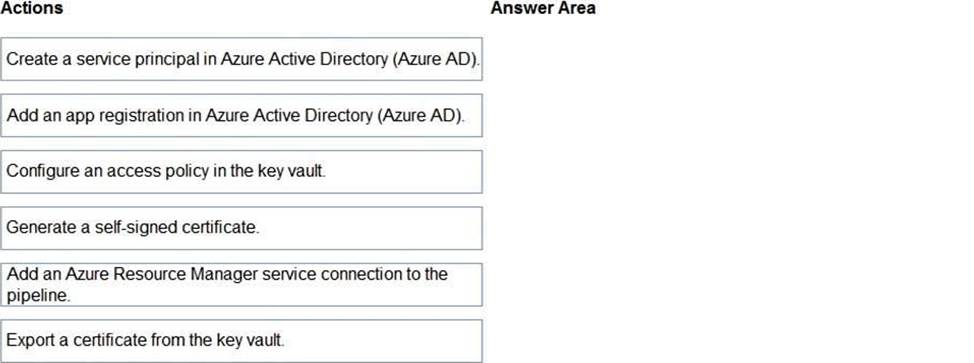
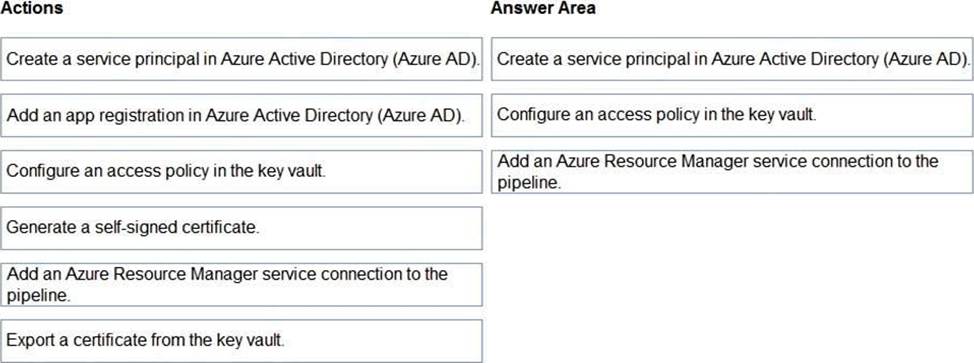
Explanation:
Step 1: Create a service principal in Azure Active Directory (Azure AD).
You will need a service principal to deploy an app to an Azure resource from Azure Pipelines.
Step 2: Configure an access policy in the key vault.
You need to secure access to your key vaults by allowing only authorized applications and users. To access the data from the vault, you will need to provide read (Get) permissions to the service principal that you will be using for authentication in the pipeline.
Select Access policy and then select + Add Access Policy to setup a new policy.
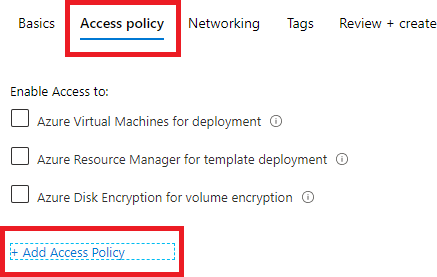
Step 3: Add an Azure Resource Manager service connection to the pipeline
You need to authorize the pipeline to deploy to Azure:
HOTSPOT –
You have a virtual machine that runs Windows Server 2019 and is managed by using Desired State Configuration (DSC).
You have the following DSC configuration.
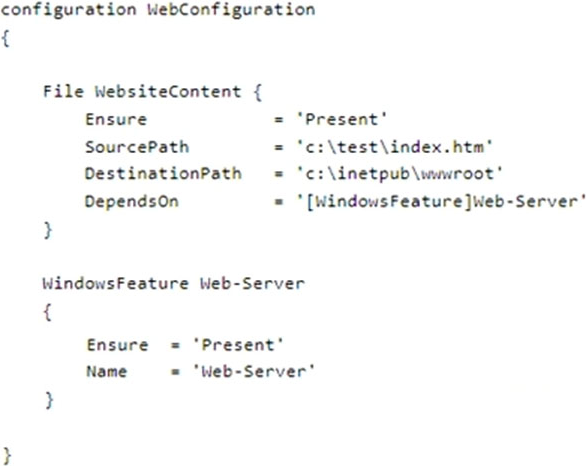
You have the following Local Configuration Manager (LCM) configuration.
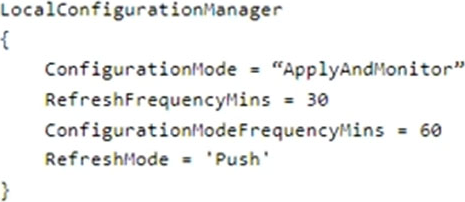
For each of the following statements, select Yes if the statement is true. Otherwise, select No. NOTE: Each correct selection is worth one point. Hot Area:


You have an Azure subscription that contains four Azure virtual machines.
You need to configure the virtual machines to use a single identity.
The solution must meet the following requirements:
• Ensure that the credentials for the identity are managed automatically.
• Support granting privileges to the identity.
Which type of identity should you use?
- A . a system-assigned managed identity
- B . a user-assigned managed identity
- C . a service principal
- D . a user account
You have an Azure subscription that contains four Azure virtual machines.
You need to configure the virtual machines to use a single identity.
The solution must meet the following requirements:
• Ensure that the credentials for the identity are managed automatically.
• Support granting privileges to the identity.
Which type of identity should you use?
- A . a system-assigned managed identity
- B . a user-assigned managed identity
- C . a service principal
- D . a user account
